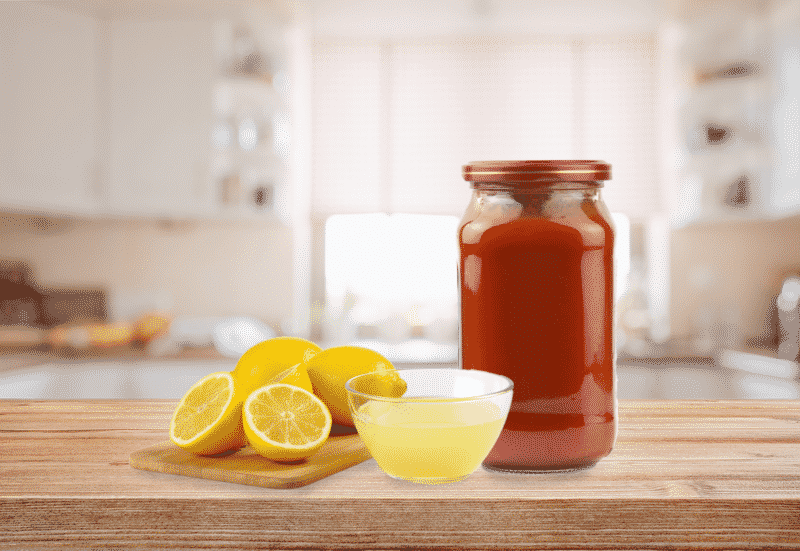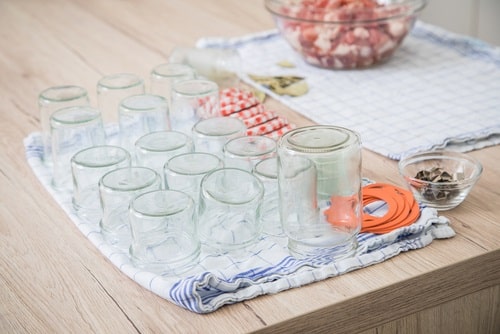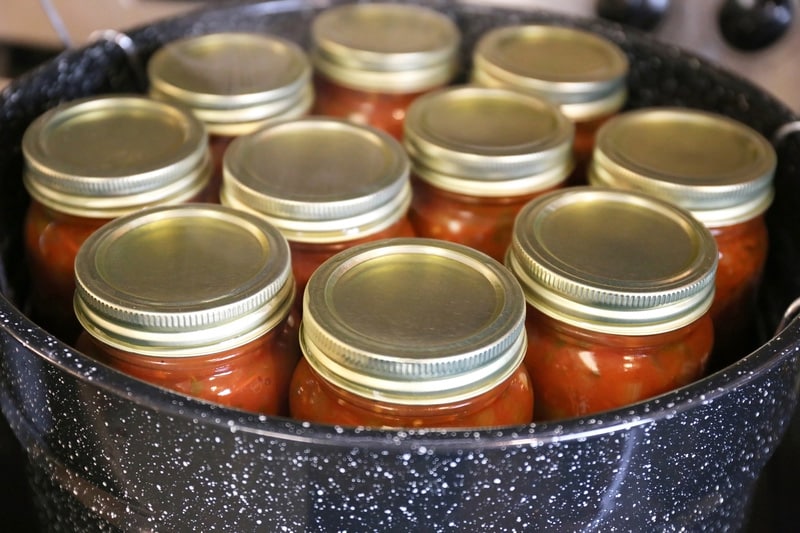
In 1994 an important change was introduced into the process of canning tomatoes. Prior to this, tomatoes had been considered an acidic food that was safe to can using the water bath method.
However, the research made it mandatory to add acid in the form of lemon juice, citric acid, or vinegar to your tomatoes when canning with the water bath method.
If using the pressure canning method, it isn’t necessary to add acid but we recommend it for extra safety.
The reason for the policy changes? Well, after compiling a lot of experimental and physical data, researchers concluded that even though tomatoes had previously been considered high acid foods, they are ultimately just fruits, and the acidity in fruits changes over time.
When unripe, tomatoes have a green color and this is when they have the lowest pH value (most acidic).
However, as time passes and the tomatoes start to become red, their pH value increases as well. From an initial pH value of around 3, it goes above the required pH of 4.6 (becomes less acidic). At this stage, tomatoes become a medium acid food.
The research didn’t end here. There is a large variety of tomatoes, and each one has a different pH value when ripe. Similarly, different regions and climate conditions can also affect a tomato’s final pH.
Thus, because it is unsafe to can low acid foods unless pressure canning, it was deemed necessary to add acid when canning tomatoes as a precaution. Thus, tomatoes are now officially considered a “medium acid food” with a pH between 4.5 and 5.2.
Of course, there are various types of edible acids. The acid that is commonly recommended when canning tomatoes is lemon juice.
However, you can also add citric acid or vinegar instead. If using lemon juice, always use bottled lemon juice as the acidity of fresh lemons varies.
The recommended amount of acid per quart of tomatoes is 2 tablespoons if you are using bottled lemon juice, ½ a teaspoon if you are using powdered citric acid, or 4 tablespoons of 5 percent acidity vinegar.
Warning: Pressure canning is more effective to kill the botulism potential. Water bath canning is a traditional method and NOT a scientifically approved method. Try at your own risk!
Pressure Canning Tomato Sauce Without Lemon Juice
Lemon juice isn’t always popular because the lemon seems to compete with rather than enhance the tomato flavor. Some say that vinegar gives the tomato sauce a pickled taste that even adding sugar does not offset.
This isn’t a problem if you are going to use the tomatoes in savory dishes which is why we recommend vinegar as an alternative to lemon juice for tomato canning.
We suggest that you do not add sugar as this affects the flavor of the tomatoes and renders them suboptimal for some recipes.
If you don’t like either of these options and citric acid is available to you, feel free to use this instead. It does not affect the taste as much as either vinegar or lemon juice does.
The reason for adding acid is to make an inhospitable environment for the Botulinum bacteria that reproduce when canning low acid foods. This bacterium causes a severe and dangerous form of food poisoning.
An acidic environment and temperatures above 240 degrees Fahrenheit can effectively kill it, eliminating all chances of food poisoning.
To sum up, pressure canning tomato sauce without lemon juice or another acid can be done.
However, if you are water bath canning, use lemon juice, vinegar, or citric acid in recommended amounts. You may add a teaspoon of salt per quart to the tomatoes as well if you like.
Pressure Canning Tomato Sauce With Vinegar Recipe
Below we will show you how to pressure-can your tomato sauce with vinegar instead of lemon juice.
- Make sure your jars are free from any sort of defects such as chips or cracks.
- Boil your jars and their caps for at least 10 minutes in a big pot of boiling water. This will sterilize your jars.
- Prepare your crushed tomatoes: Wash the tomatoes under cold running water then blanch them in boiling water until the skins split. Slip the skins off by hand and remove the cores with a sharp knife. Cut the tomatoes into quarters and heat them in a large saucepan until boiling. Boil for 5 minutes then use a potato masher to crush them. Add vinegar or citric acid plus salt.
- Once your crushed tomatoes have been prepared, put the hot fruit containing the recommended amount of vinegar into your hot jars and close the lids properly. Leave about half an inch of headspace at the top of each jar.
- Put the trivet or rack into the pressure canner first so that the jars can rest on it instead of directly on the bottom of the canner.
- Arrange your jars inside the pressure canner. Make sure the water is below the fill line and don’t submerge your jars completely in water, give them a little headspace. Ensure none of the jars are touching each other. Seal the lid and close it properly.
- Allow the pressure canner to boil with the vent open for at least 10 minutes. Steam should emerge through the vent. This is an important process that removes any clogging inside the steam vent and eliminates air from inside the canner.
- After the venting process, place the weight over the vent and maintain 11 pounds of pressure for 10 minutes.
- Shut off the heat and allow the pressure canner to cool down naturally. The cooling process will take approximately 45 minutes.
- Take the weight off, remove the lid, and remove the jars from the water.
- Place the jars onto a cooling rack and leave them to cool for at least 12 hours.
- Once cool, label the jars with the contents and the date of canning.
- Store them in a cool, dark, dry place.
To conclude
Because you have added vinegar to the tomatoes, you do not have to can them with a pressure canner. They are now acidic enough to can in a water bath.



